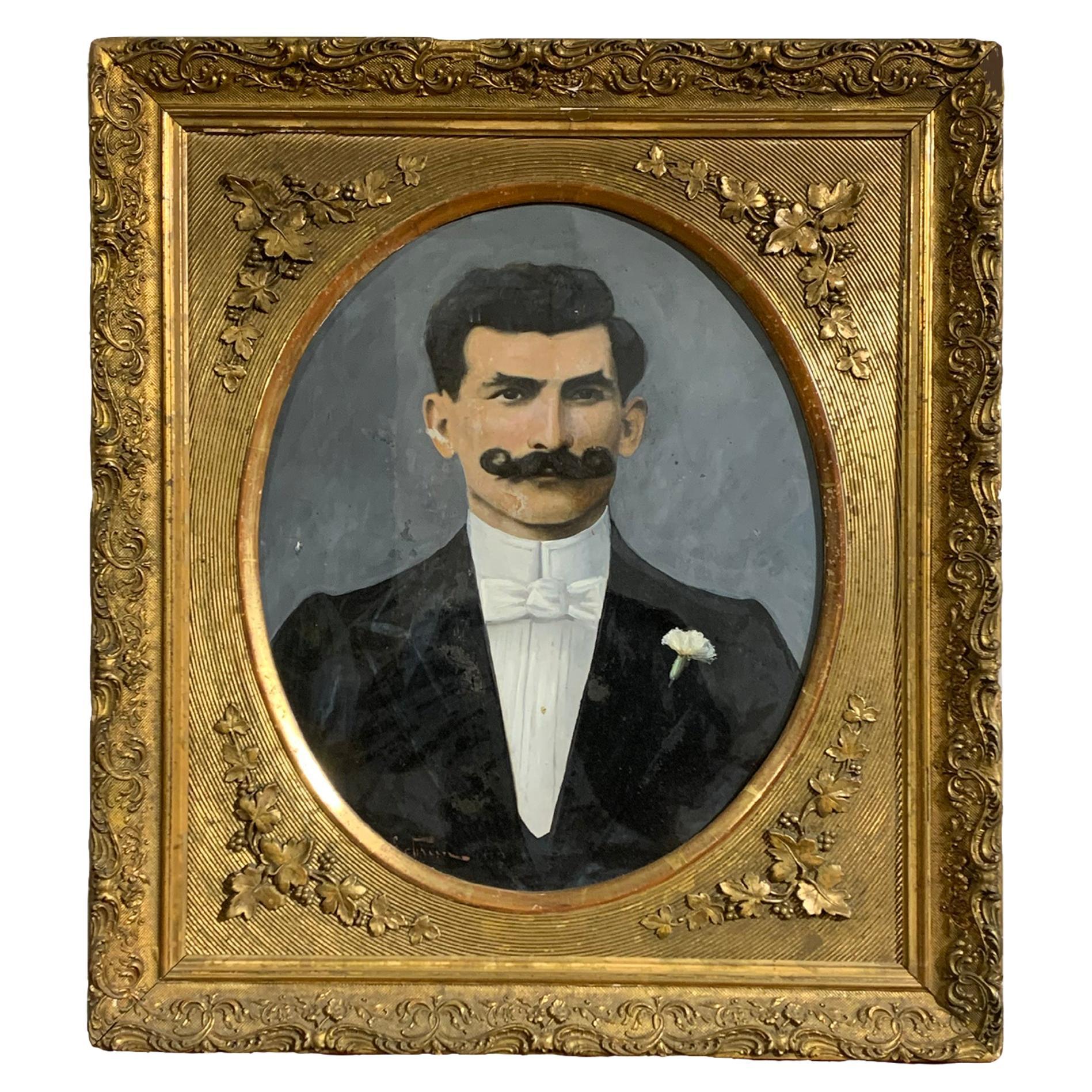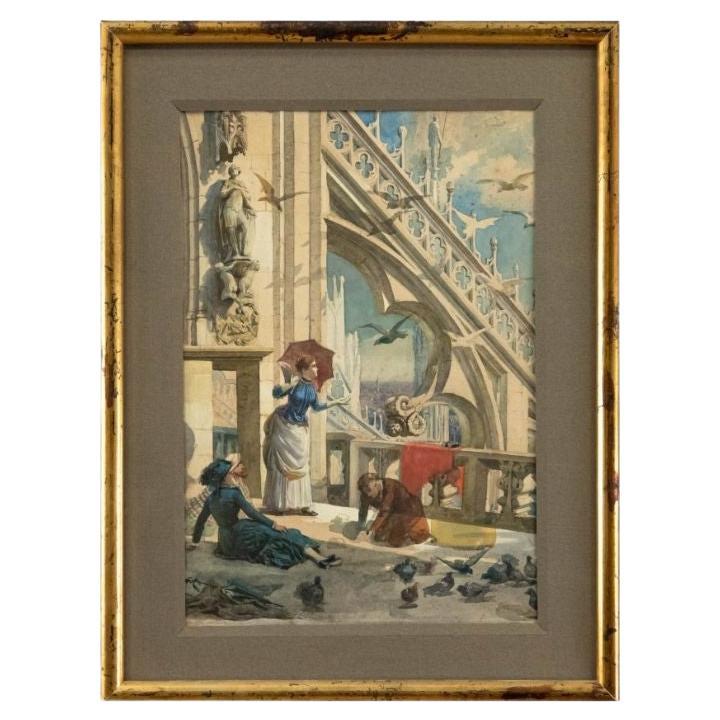Items Similar to 19th Century Views of Pompeii Paintings Tempera on Paper by Fergola
Want more images or videos?
Request additional images or videos from the seller
19th Century Views of Pompeii Paintings Tempera on Paper by Fergola
About the Item
Francesco Fergola (Naples, 1801 - there, 1875)
Pair of Views of Pompeii
Tempera on paper, 33 x 48 cm
Frame 49 x 64 cm
The two views in question are signed by Francesco Fergola, a painter, known for his work as a landscape painter, born in Naples in 1801, since, in the act of death in 1875, he is said to be seventy-four. Son of the painter Luigi and brother of Salvatore, he is not to be confused with his nephew of the same name, also a painter, and his brother, also with the same name, an internationally renowned engineer and geographer. His approach, original and particular, less influenced by the Posillipo school, compared to his brother appears more linked to the Hackertian way of his father.
Endowed with a documentary precision in the shooting of the places derived from the so-called "bird's eye view" by PJ Hackert, the first certain information on his artistic activity are linked to the Bourbon exhibitions starting from before 1826 where he appears as part of the " Royal Institute of Fine Arts "and exhibited two paintings, winning the third class silver medal. In 1830 he presented a tempera, View of Naples, and was awarded the second class silver medal; the painting can perhaps be identified with a tempera on paper, View of Naples from Capodichino (Naples, royal palace), signed and dated 1830. Francesco was also present at the Bourbon exhibition of 1835 with an Eruption of Vesuvius. The two subjects depicted here are of great charm and interest, the Forum of Pompeii and the Via dei Sepolcri, also in Pompeii. The forum represented the main square of the city of which it was the political, economic and religious fulcrum. The Roman forum of Pompeii dates back to the 2nd century BC but great works were carried out in the Augustan age. The choice of representing the forum with the view of Vesuvius in the center of the composition to dominate the city is very fascinating, thus capturing the remains of the great temple of Jupiter Capitoline, the main building of worship in the city, located on the north side of the ancient piazza, erected as early as 250 BC This view allows you to imagine how much wonder the grandeur of the forum and the monumentality of the temple, dominated by Vesuvius, must have aroused, all enriched by the charm of the ruins. Some visitors, painted with attention to detail and clothing, they enliven the composition, transferring the past into the present, depicting how much the ancient already struck contemporaries. In the other painting we find the Via dei Sepolcri depicted; as a Roman custom, the road leading out of the city was used as a funerary space, flanked by sepulchral monuments. The street was beautifully immortalized by the words of Alexandre Dumas taken from Corricolo "a road that offers at its extremity., Like a great arch through which one sees nothing but the sky, that door by which one went from the city of the dead to the city ??of the living; that one surrounds all this with silence, solitude, meditation, and one will have an idea, still very incomplete, of the marvelous aspect that the suburb of Pompeii presents ". depicting how the ancient already struck contemporaries. In the other painting we find the Via dei Sepolcri depicted; as a Roman custom, the road leading out of the city was used as a funerary space, flanked by sepulchral monuments. The street was beautifully immortalized by the words of Alexandre Dumas taken from Corricolo "a road that offers at its extremity., Like a great arch through which one sees nothing but the sky, that door by which one went from the city of the dead to the city ??of the living; that one surrounds all this with silence, solitude, meditation, and one will have an idea, still very incomplete, of the marvelous aspect that the suburb of Pompeii presents ". depicting how the ancient already struck contemporaries. In the other painting we find the Via dei Sepolcri depicted; as a Roman custom, the road leading out of the city was used as a funerary space, flanked by sepulchral monuments. The street was beautifully immortalized by the words of Alexandre Dumas taken from Corricolo "a road that offers at its extremity., Like a great arch through which one sees nothing but the sky, that door by which one went from the city of the dead to the city ??of the living; that one surrounds all this with silence, solitude, meditation, and one will have an idea, still very incomplete, of the marvelous aspect that the suburb of Pompeii presents ". another painting depicts the Via dei Sepolcri; as a Roman custom, the road leading out of the city was used as a funerary space, flanked by sepulchral monuments. The street was beautifully immortalized by the words of Alexandre Dumas taken from Corricolo "a road that offers at its extremity., Like a great arch through which one sees nothing but the sky, that door by which one went from the city of the dead to the city ??of the living; that one surrounds all this with silence, solitude, meditation, and one will have an idea, still very incomplete, of the marvelous aspect that the suburb of Pompeii presents ". another painting depicts the Via dei Sepolcri; as a Roman custom, the road leading out of the city was used as a funerary space, flanked by sepulchral monuments. The street was beautifully immortalized by the words of Alexandre Dumas taken from Corricolo "a road that offers at its extremity., Like a great arch through which one sees nothing but the sky, that door by which one went from the city of the dead to the city ??of the living; that one surrounds all this with silence, solitude, meditation, and one will have an idea, still very incomplete, of the marvelous aspect that the suburb of Pompeii presents ". The street was beautifully immortalized by the words of Alexandre Dumas taken from Corricolo "a road that offers at its extremity., Like a great arch through which one sees nothing but the sky, that door by which one went from the city of the dead to the city ??of the living; that one surrounds all this with silence, solitude, meditation, and one will have an idea, still very incomplete, of the marvelous aspect that the suburb of Pompeii presents ". The street was beautifully immortalized by the words of Alexandre Dumas taken from Corricolo "a road that offers at its extremity., Like a great arch through which one sees nothing but the sky, that door by which one went from the city of the dead to the city ??of the living; that one surrounds all this with silence, solitude, meditation, and one will have an idea, still very incomplete, of the marvelous aspect that the suburb of Pompeii presents ".
- Dimensions:Height: 19.3 in (49 cm)Width: 25.2 in (64 cm)Depth: 1.58 in (4 cm)
- Sold As:Set of 2
- Materials and Techniques:
- Place of Origin:
- Period:
- Date of Manufacture:19th Century
- Condition:Wear consistent with age and use.
- Seller Location:Milan, IT
- Reference Number:1stDibs: LU5918226732962

About the Seller
5.0
Vetted Seller
These experienced sellers undergo a comprehensive evaluation by our team of in-house experts.
Established in 2000
1stDibs seller since 2021
26 sales on 1stDibs
Typical response time: 12 hours
- ShippingRetrieving quote...Ships From: Milan, Italy
- Return PolicyA return for this item may be initiated within 14 days of delivery.
More From This SellerView All
- 18th Century Nine Views of Rome Painting Tempera on PaperLocated in Milan, ITXVIII century Views of Rome (9) Tempera on paper, 9 x 14 cm; with frame 34 x 40 cm During the seventeenth century the fashion of the Grand Tour spread among the aristocracy, a ...Category
Antique 18th Century Italian Paintings
MaterialsPaper
- 19th Century View of the Naviglio with the Duomo Painting Tempera on CanvasLocated in Milan, ITGiuseppe Riva (Ivrea, 1834 - 1916). View of the Naviglio with the Duomo. Tempera on canvas, 49.5 x 69.5 cm. Signed lower left "Riva G." This cit...Category
Antique 19th Century Italian Paintings
MaterialsCanvas
- 19th Century View from the Spiers of the Duomo Painting Watercolor on PaperLocated in Milan, ITNineteenth century View from the spiers of the Milan Cathedral Watercolor on paper, 43 x 30 cm The watercolor in question depicts some ladies and gentlemen intent on enjoyi...Category
Antique 19th Century Italian Paintings
MaterialsPaper
- 20th Century Mountain View Painting Tempera on Cardboard by Piero LeidiLocated in Milan, ITPiero Leidi (Brescia, 1892 - Bedizzole, 1976) Mountain view with Ponte di Legno Tempera on cardboard, 23 x 17 cm Signed lower right "P.Leidi", dated 1943 and inscribed on the back Piero Leidi, an artist of Brescia origins, studied in Lugano with Luigi Rossi...Category
20th Century Italian Paintings
MaterialsPaint, Paper
- 19th Century Marine View Painting Oil on CanvasLocated in Milan, ITNineteenth century Marine view Oil on canvas, 74.5 x 100.5 cm Frame 100 x 126 cm The arrival of the storm is announced on the left side of the canvas by the presence of r...Category
Antique 19th Century Italian Paintings
MaterialsCanvas
- 18th Century Four Rural Scenes Painting Tempera on PaperLocated in Milan, ITXVIII century Rural scenes (4) Tempera on paper, 20 x 31 cm With 18th century Venetian mirrored frame, 31 x 39 cm.Category
Antique 18th Century Italian Paintings
MaterialsPaper
You May Also Like
- 19th Century Tempera on Paper Italian Antique Religious Painting, 1850Located in Vicoforte, PiedmontAntique Italian painting from 19th century. Framework tempera on paper, applied on canvas, depicting a religious subject Adoration of the shepherds of good pictorial quality. Frame i...Category
Antique Mid-19th Century Italian Paintings
MaterialsPaper
- Late 19th Century Tempera on Paper Architectural LandscapeLocated in Firenze, FIBeautiful fantastic landscape with neoclassical architectural structures and classical monuments created with clear references to Florentine classicism: in fact, the sculpture of the...Category
Antique Late 19th Century Italian Paintings
MaterialsCanvas, Wood, Paper
- Late 19th Century Male Portrait, Tempera on PaperLocated in Firenze, FIPortrait of a man with a twisted moustache, in the typical dark suit of the Art Nouveau era of the end of the 19th century. Gilt tablet frame, with floral decorations. Tempera techn...Category
Antique Late 19th Century French Paintings
MaterialsGiltwood, Paper
- 18th Century Tempera on Canvas Italian Painting View with Architecture, 1770Located in Vicoforte, PiedmontAntique Italian painting from the 18th century. Tempera artwork on canvas depicting a view with architecture, mask and lateral cornucopias of good pictorial quality. Painting of grea...Category
Antique 1770s Italian Paintings
MaterialsCanvas
- 18th Century Tempera on Paper Italian Antique Landscape Painting, 1780Located in Vicoforte, PiedmontAntique Italian painting from the late 18th century. Tempera on paper fixed on canvas with frame (see photo) depicting landscape with figures, animals and architecture of good pictor...Category
Antique Late 18th Century Italian Paintings
MaterialsPaper
- 19th Century Painting, View of a North Italian Village by a LakeLocated in Belmont, MAVery decorative painting of an unknown artist. "View of a North Italian Village by a Lake," oil on canvas. Measurements without frame: 11.5 x 19 inches.Category
Antique Early 1900s Italian Romantic Paintings
MaterialsCanvas
Recently Viewed
View AllMore Ways To Browse
Antique Door Painting
Ancient Roman Painting
Pair Of Arched Doors
Italy Ruins Painting
Italian Ruins Painting
Medal Charm
Painting Ancient Ruins
Antique Forum
Italian Arched Doors
Jupiter Painting
Roman Ruins Painting
Vesuvius Painting
Bourbon Painting
Painting Of Bourbon
Roman Medal
Antique Furniture Forum
Antique Religious Medal
Antique Religious Medals





